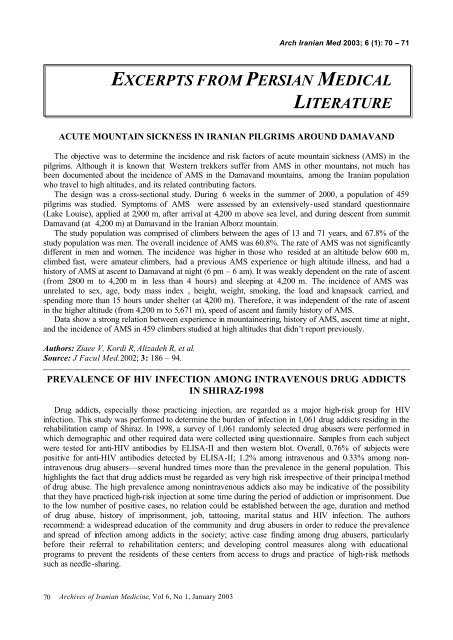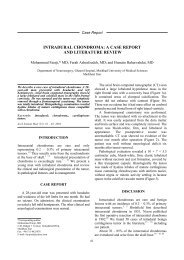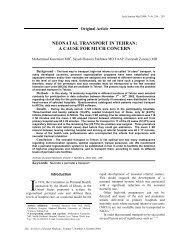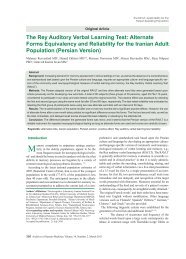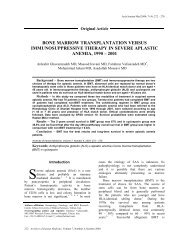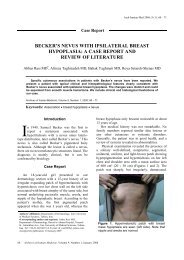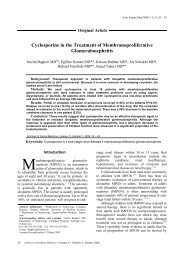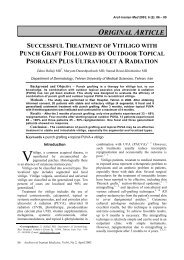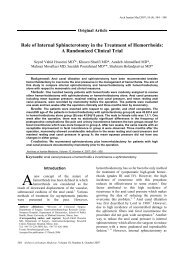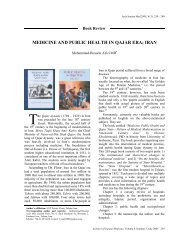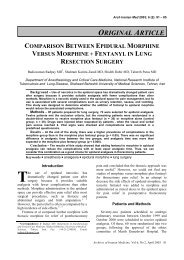EXCERPTS FROM PERSIAN MEDICAL LITERATURE
EXCERPTS FROM PERSIAN MEDICAL LITERATURE
EXCERPTS FROM PERSIAN MEDICAL LITERATURE
You also want an ePaper? Increase the reach of your titles
YUMPU automatically turns print PDFs into web optimized ePapers that Google loves.
70<br />
Archives of Iranian Medicine, Vol 6, No 1, January 2003<br />
Arch Iranian Med 2003; 6 (1): 70 – 71<br />
<strong>EXCERPTS</strong> <strong>FROM</strong> <strong>PERSIAN</strong> <strong>MEDICAL</strong><br />
ACUTE MOUNTAIN SICKNESS IN IRANIAN PILGRIMS AROUND DAMAVAND<br />
The objective was to determine the incidence and risk factors of acute mountain sickness (AMS) in the<br />
pilgrims. Although it is known that Western trekkers suffer from AMS in other mountains, not much has<br />
been documented about the incidence of AMS in the Damavand mountains, among the Iranian population<br />
who travel to high altitudes, and its related contributing factors.<br />
The design was a cross-sectional study. During 6 weeks in the summer of 2000, a population of 459<br />
pilgrims was studied. Symptoms of AMS were assessed by an extensively-used standard questionnaire<br />
(Lake Louise), applied at 2,900 m, after arrival at 4,200 m above sea level, and during descent from summit<br />
Damavand (at 4,200 m) at Damavand in the Iranian Alborz mountain.<br />
The study population was comprised of climbers between the ages of 13 and 71 years, and 67.8% of the<br />
study population was men. The overall incidence of AMS was 60.8%. The rate of AMS was not significantly<br />
different in men and women. The incidence was higher in those who resided at an altitude below 600 m,<br />
climbed fast, were amateur climbers, had a previous AMS experience or high altitude illness, and had a<br />
history of AMS at ascent to Damavand at night (6 pm – 6 am). It was weakly dependent on the rate of ascent<br />
(from 2,800 m to 4,200 m in less than 4 hours) and sleeping at 4,200 m. The incidence of AMS was<br />
unrelated to sex, age, body mass index , height, weight, smoking, the load and knapsack carried, and<br />
spending more than 15 hours under shelter (at 4,200 m). Therefore, it was independent of the rate of ascent<br />
in the higher altitude (from 4,200 m to 5,671 m), speed of ascent and family history of AMS.<br />
Data show a strong relation between experience in mountaineering, history of AMS, ascent time at night,<br />
and the incidence of AMS in 459 climbers studied at high altitudes that didn’t report previously.<br />
Authors: Ziaee V, Kordi R, Alizadeh R, et al.<br />
Source: J Facul Med.2002; 3: 186 – 94.<br />
<strong>LITERATURE</strong><br />
PREVALENCE OF HIV INFECTION AMONG INTRAVENOUS DRUG ADDICTS<br />
IN SHIRAZ-1998<br />
Drug addicts, especially those practicing injection, are regarded as a major high-risk group for HIV<br />
infection. This study was performed to determine the burden of infection in 1,061 drug addicts residing in the<br />
rehabilitation camp of Shiraz. In 1998, a survey of 1,061 randomly selected drug abusers were performed in<br />
which demographic and other required data were collected using questionnaire. Samples from each subject<br />
were tested for anti-HIV antibodies by ELISA-II and then western blot. Overall, 0.76% of subjects were<br />
positive for anti-HIV antibodies detected by ELISA-II; 1.2% among intravenous and 0.33% among nonintravenous<br />
drug abusers—several hundred times more than the prevalence in the general population. This<br />
highlights the fact that drug addicts must be regarded as very high risk irrespective of their principal method<br />
of drug abuse. The high prevalence among nonintravenous addicts also may be indicative of the possibility<br />
that they have practiced high-risk injection at some time during the period of addiction or imprisonment. Due<br />
to the low number of positive cases, no relation could be established between the age, duration and method<br />
of drug abuse, history of imprisonment, job, tattooing, marital status and HIV infection. The authors<br />
recommend: a widespread education of the community and drug abusers in order to reduce the prevalence<br />
and spread of infection among addicts in the society; active case finding among drug abusers, particularly<br />
before their referral to rehabilitation centers; and developing control measures along with educational<br />
programs to prevent the residents of these centers from access to drugs and practice of high-risk methods<br />
such as needle-sharing.
Authors: Mirahmadizadeh AR, Kadivar MR, Ghane-Shirazi R, et al.<br />
Source: J Gorgan Univ Med Sci.2001; 8: 39.<br />
STRONTIUM-90 IN THE FRESH MILK AND MILK POWDER CONSUMED BY<br />
CHILDREN IN TEHRAN AND NORTH OF IRAN<br />
Strontium-90, one of the radionuclides produced during the fission of uranium and plutonium in nuclear<br />
explosions and reactors can readily replace calcium in the milk. It can put public health in danger both<br />
through its long physical half-life (over 28 years) and its presence in the milk, a perfect nutrient for children.<br />
In this study, we collected 50 samples of fresh milk from Tehran, eastern and western Azarbaijan, and<br />
Mazandaran, and another 25 samples of milk powder imported from the Netherlands, Denmark and Japan.<br />
After extraction of strontium by the method of tri-butylphosphate (TBP) and preparation of the samples, Sr-<br />
90 reacted in the radioactive equilibrium with Y-90 that was measured by a low-level beta detector.<br />
The observations obtained in the study show that the mean concentration of Sr-90 in the samples of fresh<br />
milk from Tehran, eastern and western Azarbaijan, and Mazandaran, was 5.43, 1.76, 1.70 and 2.90 Bq/kg<br />
respectively, while in the milk powder imported from Japan, Denmark and Netherlands, it was 6.93, 11.8 and<br />
19.64 Bq/kg, respectively.<br />
These results show that the mean concentration of Sr-90 in the imported milk powder was significantly<br />
higher than normal and thus, indicate the necessity of a precise control of imported nutrition products for<br />
children.<br />
Authors: Mesbah A, Paykarjoo SH, Karimi-Nejad M.<br />
Source: Med J Tabriz Univ Med Sci. 2002; 53: 53 – 8.<br />
RELATIONSHIP BETWEEN THE INCIDENCE OF INTESTINAL PARASITES AND<br />
MENTAL PERFORMANCE IN CHILDREN<br />
An appropriate mental function is required for optimum performance at every age. There is evidence on<br />
the relationship between intestinal infection and effective mental performance. This study was carried out to<br />
determine the incidence of infection due to intestinal parasites and its relationship with mental performance<br />
in students of the Robat-Karim region.<br />
This descriptive strategy study was conducted on 268 girls and 332 boys with an age range of 6 – 12<br />
years. For sampling, the cluster method was applied on 128 schools in the region. After stool examination<br />
using direct and ether methods, 150 contaminated children were chosen as the case group and 150 healthy<br />
children as the control group. Both groups were similar in socio-economic, cultural, and nutritional status.<br />
For evaluation of mental performance, coding, arithmetic, digit-span forward/backward and fluency tests<br />
were used.<br />
The incidence rate of contamination was 28.7% and arithmetic marks of control, cases with protozoal<br />
and/or helminthic infection was 8.44 ± 2.59, 7.9 ± 2.73, and 7.67 ± 2.45 respectively. In addition, the groups<br />
were similar regarding coding, but fluence was 4.61 ± 2.46, 4.79 ± 2.59, and 4.33 ± 2.5, respectively<br />
(p < 0.03). Mental performance was 7.82 ± 2.78 and 6.5 ± 2.92, respectively (p < 0.004). The most common<br />
form of parasite among children was Giardia lamblia.<br />
It was concluded that healthy students have a higher mental performance and it is recommended to treat<br />
cases with parasitic contamination.<br />
Authors: Partoie F, Khalili GH.<br />
Source: Feyz. 2002; 20: 34.<br />
Archives of Iranian Medicine, Vol 6, No 1, January 2003<br />
71


